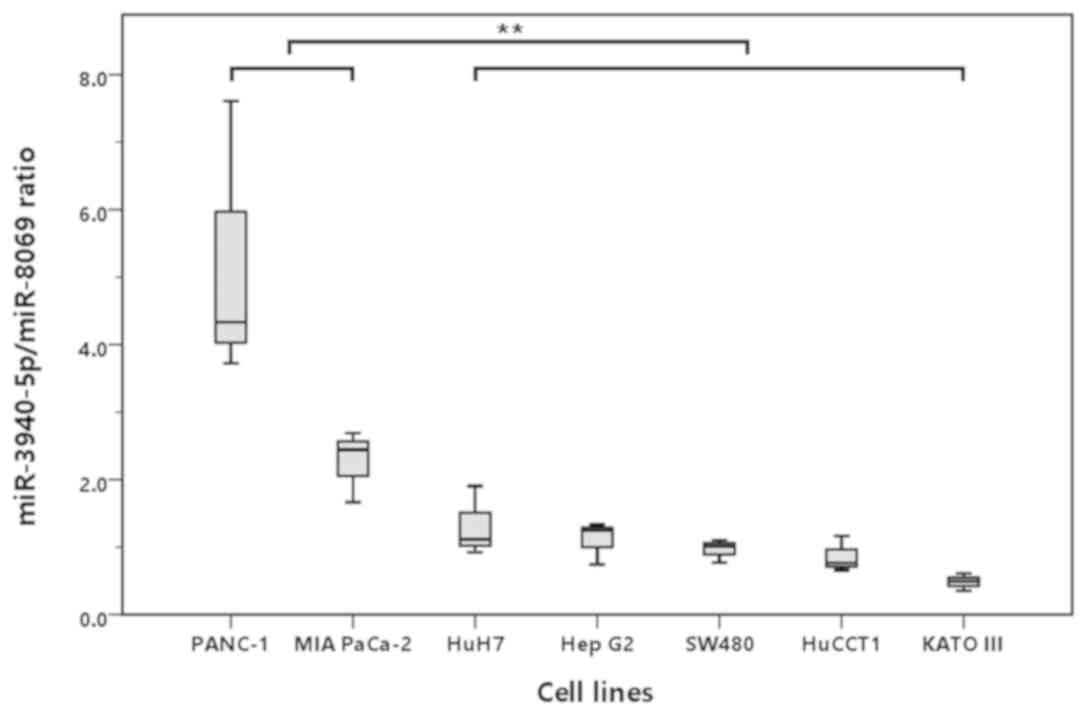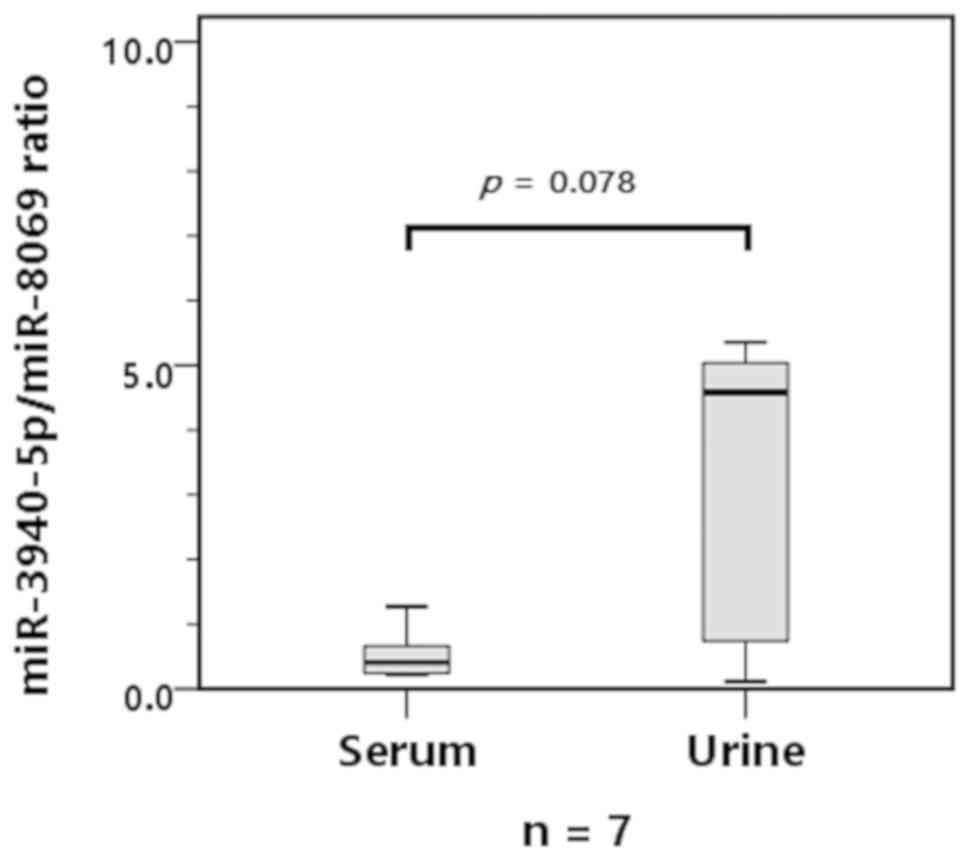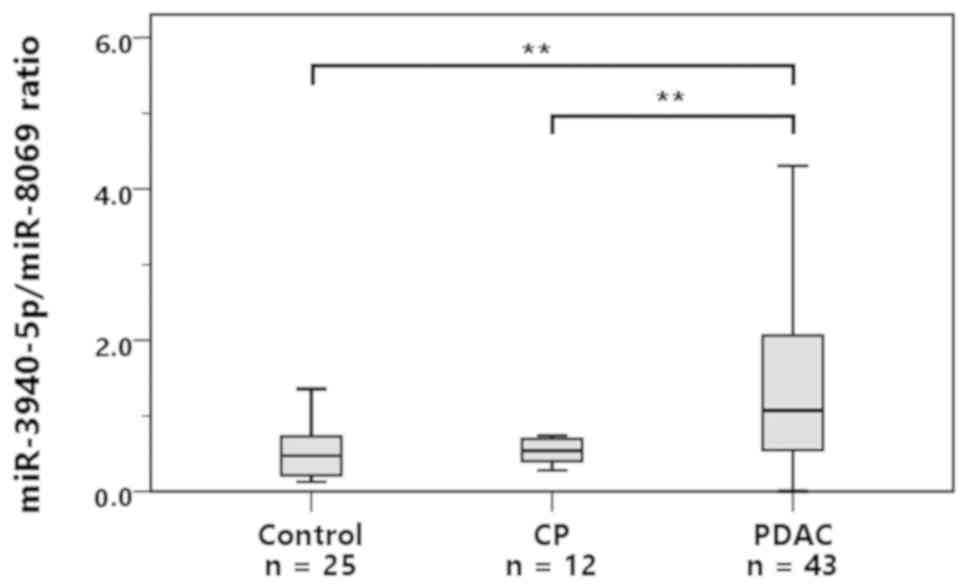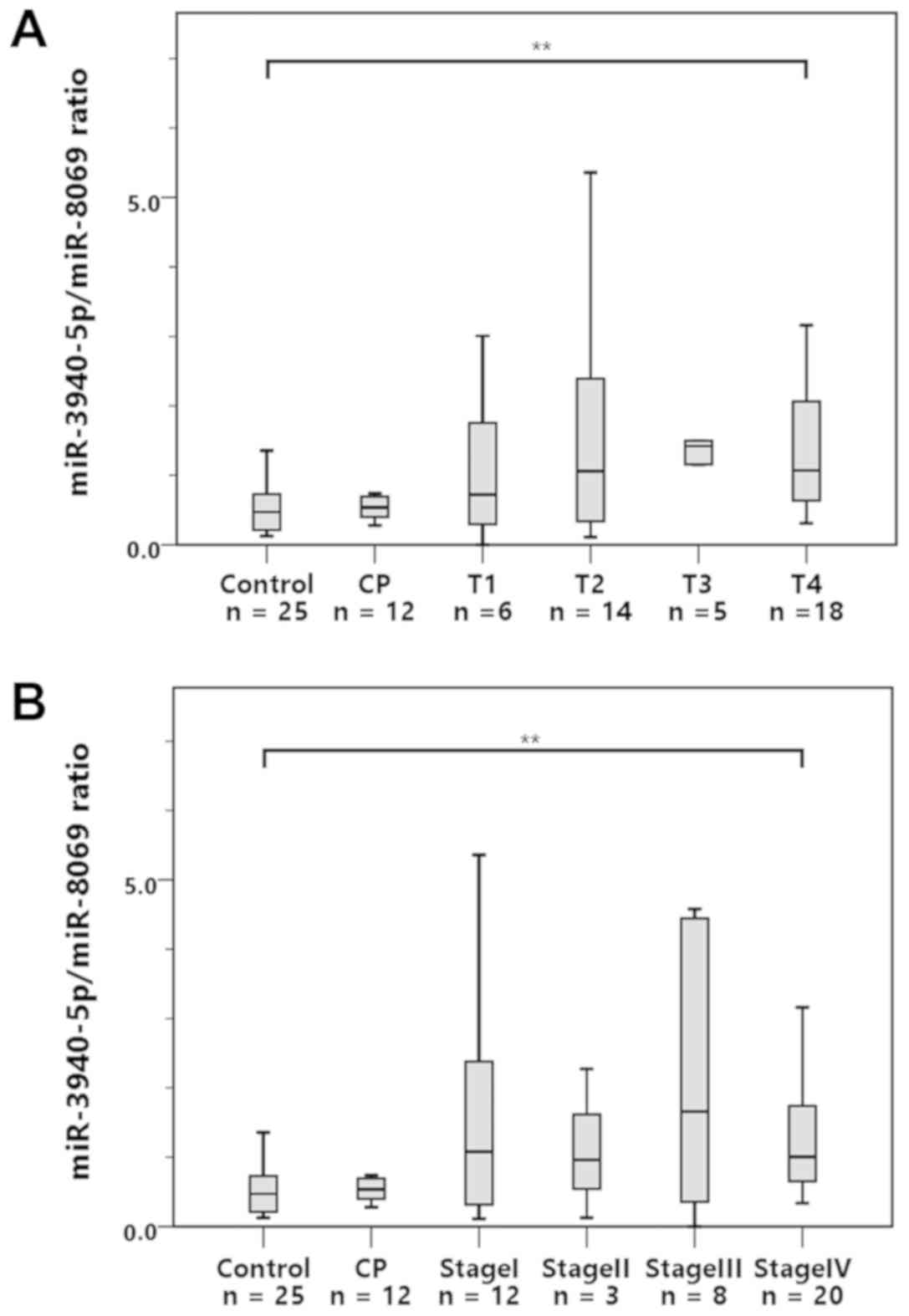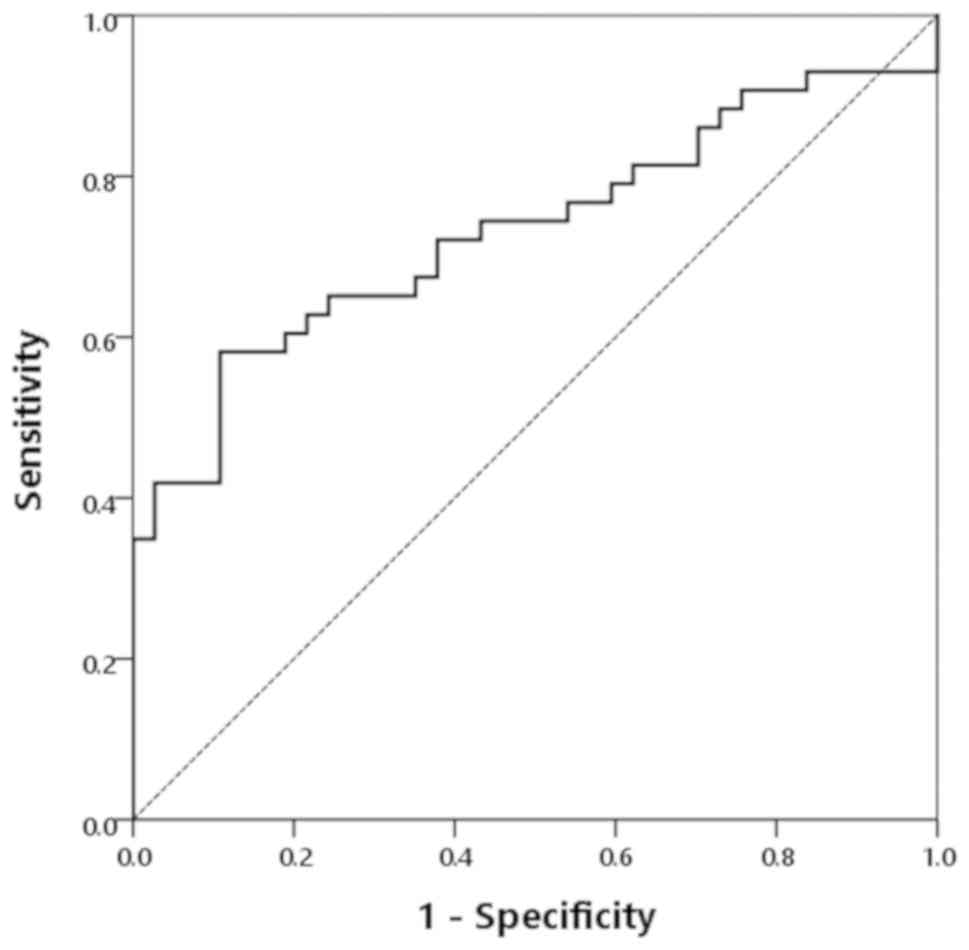|
1
|
Rahib L, Smith BD, Aizenberg R, Rosenzweig
AB, Fleshman JM and Matrisian LM: Projecting cancer incidence and
deaths to 2030: The unexpected burden of thyroid, liver, and
pancreas cancers in the United States. Cancer Res. 74:2913–2921.
2014. View Article : Google Scholar : PubMed/NCBI
|
|
2
|
Kim JE, Lee KT, Lee JK, Paik SW, Rhee JC
and Choi KW: Clinical usefulness of carbohydrate antigen 19-9 as a
screening test for pancreatic cancer in an asymptomatic population.
J Gastroenterol Hepatol. 19:182–186. 2004. View Article : Google Scholar : PubMed/NCBI
|
|
3
|
Chang CY, Huang SP, Chiu HM, Lee YC, Chen
MF and Lin JT: Low efficacy of serum levels of CA 19-9 in
prediction of malignant diseases in asymptomatic population in
Taiwan. Hepatogastroenterology. 53:1–4. 2006.PubMed/NCBI
|
|
4
|
Yachida S, Jones S, Bozic I, Antal T,
Leary R, Fu B, Kamiyama M, Hruban RH, Eshleman JR, Nowak MA, et al:
Distant metastasis occurs late during the genetic evolution of
pancreatic cancer. Nature. 467:1114–1117. 2010. View Article : Google Scholar : PubMed/NCBI
|
|
5
|
Michael MZ, O'Connor SM, van Holst
Pellekaan NG, Young GP and James RJ: Reduced accumulation of
specific microRNAs in colorectal neoplasia. Mol Cancer Res.
1:882–891. 2003.PubMed/NCBI
|
|
6
|
Iorio MV, Ferracin M, Liu CG, Veronese A,
Spizzo R, Sabbioni S, Magri E, Pedriali M, Fabbri M, Campiglio M,
et al: MicroRNA gene expression deregulation in human breast
cancer. Cancer Res. 65:7065–7070. 2005. View Article : Google Scholar : PubMed/NCBI
|
|
7
|
Johnson SM, Grosshans H, Shingara J, Byrom
M, Jarvis R, Cheng A, Labourier E, Reinert KL, Brown D and Slack
FJ: RAS is regulated by the let-7 microRNA family. Cell.
120:635–647. 2005. View Article : Google Scholar : PubMed/NCBI
|
|
8
|
Li A, Omura N, Hong SM, Vincent A, Walter
K, Griffith M, Borges M and Goggins M: Pancreatic cancers
epigenetically silence SIP1 and hypomethylate and overexpress
miR-200a/200b in association with elevated circulating miR-200a and
miR-200b levels. Cancer Res. 70:5226–5237. 2010. View Article : Google Scholar : PubMed/NCBI
|
|
9
|
Abue M, Yokoyama M, Shibuya R, Tamai K,
Yamaguchi K, Sato I, Tanaka N, Hamada S, Shimosegawa T, Sugamura K
and Satoh K: Circulating miR-483-3p and miR-21 is highly expressed
in plasma of pancreatic cancer. Int J Oncol. 46:539–547. 2015.
View Article : Google Scholar : PubMed/NCBI
|
|
10
|
Panarelli NC, Chen YT, Zhou XK,
Kitabayashi N and Yantiss RK: MicroRNA expression aids the
preoperative diagnosis of pancreatic ductal adenocarcinoma.
Pancreas. 41:685–690. 2012.PubMed/NCBI
|
|
11
|
Hong TH and Park IY: MicroRNA expression
profiling of diagnostic needle aspirates from surgical pancreatic
cancer specimens. Ann Surg Treat Res. 87:290–297. 2014. View Article : Google Scholar : PubMed/NCBI
|
|
12
|
Sadakari Y, Ohtsuka T, Ohuchida K,
Tsutsumi K, Takahata S, Nakamura M, Mizumoto K and Tanaka M:
MicroRNA expression analyses in preoperative pancreatic juice
samples of pancreatic ductal adenocarcinoma. JOP. 11:587–592.
2010.PubMed/NCBI
|
|
13
|
Wang J, Raimondo M, Guha S, Chen J, Diao
L, Dong X, Wallace MB, Killary AM, Frazier ML, Woodward TA, et al:
Circulating microRNAs in pancreatic juice as candidate biomarkers
of pancreatic cancer. J Cancer. 5:696–705. 2014. View Article : Google Scholar : PubMed/NCBI
|
|
14
|
Mitchell PS, Parkin RK, Kroh EM, Fritz BR,
Wyman SK, Pogosova-Agadjanyan EL, Peterson A, Noteboom J, O'Briant
KC, Allen A, et al: Circulating microRNAs as stable blood-based
markers for cancer detection. Proc Natl Acad Sci USA.
105:10513–10518. 2008. View Article : Google Scholar : PubMed/NCBI
|
|
15
|
Valadi H, Ekström K, Bossios A, Sjöstrand
M, Lee JJ and Lötvall JO: Exosome-mediated transfer of mRNAs and
microRNAs is a novel mechanism of genetic exchange between cells.
Nat Cell Biol. 9:654–659. 2007. View
Article : Google Scholar : PubMed/NCBI
|
|
16
|
Zhang J, Li S, Li L, Li M, Guo C, Yao J
and Mi S: Exosome and exosomal microRNA: Trafficking, sorting, and
function. Genomics Proteomics Bioinformatics. 13:17–24. 2015.
View Article : Google Scholar : PubMed/NCBI
|
|
17
|
Mlcochova H, Hezova R, Stanik M and Slaby
O: Urine microRNAs as potential noninvasive biomarkers in urologic
cancers. Urol Oncol. 32:41.e1–e9. 2014. View Article : Google Scholar
|
|
18
|
Øverbye A, Skotland T, Koehler CJ, Thiede
B, Seierstad T, Berge V, Sandvig K and Llorente A: Identification
of prostate cancer biomarkers in urinary exosomes. Oncotarget.
6:30357–30376. 2015. View Article : Google Scholar : PubMed/NCBI
|
|
19
|
Franzen CA, Blackwell RH, Foreman KE, Kuo
PC, Flanigan RC and Gupta GN: Urinary exosomes: The potential for
biomarker utility, intercellular signaling and therapeutics in
urological malignancy. J Urol. 195:1331–1339. 2016. View Article : Google Scholar : PubMed/NCBI
|
|
20
|
Conde-Vancells J, Rodriguez-Suarez E,
Gonzalez E, Berisa A, Gil D, Embade N, Valle M, Luka Z, Elortza F,
Wagner C, et al: Candidate biomarkers in exosome-like vesicles
purified from rat and mouse urine samples. Proteomics Clin Appl.
4:416–425. 2010. View Article : Google Scholar : PubMed/NCBI
|
|
21
|
Gildea JJ, Carlson JM, Schoeffel CD, Carey
RM and Felder RA: Urinary exosome miRNome analysis and its
applications to salt sensitivity of blood pressure. Clin Biochem.
46:1131–1134. 2013. View Article : Google Scholar : PubMed/NCBI
|
|
22
|
Ballehaninna UK and Chamberlain RS: The
clinical utility of serum CA 19-9 in the diagnosis, prognosis and
management of pancreatic adenocarcinoma: An evidence based
appraisal. J Gastrointest Oncol. 3:105–119. 2012.PubMed/NCBI
|
|
23
|
Stiksma J, Grootendorst DC and van der
Linden PW: CA 19-9 as a marker in addition to CEA to monitor
colorectal cancer. Clin Colorectal Cancer. 13:239–244. 2014.
View Article : Google Scholar : PubMed/NCBI
|
|
24
|
Pandey D, Sharma R, Sharma S and Salhan S:
Unusually high serum levels of CA 19-9 in an ovarian tumour:
Malignant or benign? J Clin Diagn Res. 11:QD08–QD10.
2017.PubMed/NCBI
|
|
25
|
Debernardi S, Massat NJ, Radon TP,
Sangaralingam A, Banissi A, Ennis DP, Dowe T, Chelala C, Pereira
SP, Kocher HM, et al: Noninvasive urinary miRNA biomarkers for
early detection of pancreatic adenocarcinoma. Am J Cancer Res.
5:3455–3466. 2015.PubMed/NCBI
|
|
26
|
Kao HW, Pan CY, Lai CH, Wu CW, Fang WL,
Huang KH and Lin WC: Urine miR-21-5p as a potential non-invasive
biomarker for gastric cancer. Oncotarget. 8:56389–56397. 2017.
View Article : Google Scholar : PubMed/NCBI
|
|
27
|
Yasui T, Yanagida T, Ito S, Konakade Y,
Takeshita D, Naganawa T, Nagashima K, Shimada T, Kaji N, Nakamura
Y, et al: Unveiling massive numbers of cancer-related
urinary-microRNA candidates via nanowires. Sci Adv. 3:e17011332017.
View Article : Google Scholar : PubMed/NCBI
|
|
28
|
Weber JA, Baxter DH, Zhang S, Huang DY,
Huang KH, Lee MJ, Galas DJ and Wang K: The microRNA spectrum in 12
body fluids. Clin Chem. 56:1733–1741. 2010. View Article : Google Scholar : PubMed/NCBI
|
|
29
|
Brunetto GS, Massoud R, Leibovitch EC,
Caruso B, Johnson K, Ohayon J, Fenton K, Cortese I and Jacobson S:
Digital droplet PCR (ddPCR) for the precise quantification of human
T-lymphotropic virus 1 proviral loads in peripheral blood and
cerebrospinal fluid of HAM/TSP patients and identification of viral
mutations. J Neurovirol. 20:341–351. 2014. View Article : Google Scholar : PubMed/NCBI
|
|
30
|
Zhao S, Lin H, Chen S, Yang M, Yan Q, Wen
C, Hao Z, Yan Y, Sun Y, Hu J, et al: Sensitive detection of Porcine
circovirus-2 by droplet digital polymerase chain reaction. J Vet
Diagn Invest. 27:784–788. 2015. View Article : Google Scholar : PubMed/NCBI
|
|
31
|
Pekin D, Skhiri Y, Baret JC, Le Corre D,
Mazutis L, Salem CB, Millot F, El Harrak A, Hutchison JB, Larson
JW, et al: Quantitative and sensitive detection of rare mutations
using droplet-based microfluidics. Lab Chip. 11:2156–2166. 2011.
View Article : Google Scholar : PubMed/NCBI
|
|
32
|
Gutiérrez-Aguirre I, Rački N, Dreo T and
Ravnikar M: Droplet digital PCR for absolute quantification of
pathogens. Methods Mol Biol. 1302:331–347. 2015. View Article : Google Scholar : PubMed/NCBI
|
|
33
|
Conte D, Verri C, Borzi C, Suatoni P,
Pastorino U, Sozzi G and Fortunato O: Novel method to detect
microRNAs using chip-based QuantStudio 3D digital PCR. BMC
Genomics. 16:8492015. View Article : Google Scholar : PubMed/NCBI
|
|
34
|
Sun Y, Su B, Zhang P, Xie H, Zheng H, Xu
Y, Du Q, Zeng H, Zhou X, Chen C and Gao W: Expression of miR-150
and miR-3940-5p is reduced in non-small cell lung carcinoma and
correlates with clinicopathological features. Oncol Rep.
29:704–712. 2013. View Article : Google Scholar : PubMed/NCBI
|
|
35
|
Ren K, Li Y, Lu H, Li Z and Han X:
miR-3940-5p functions as a tumor suppressor in non-small cell lung
cancer cells by targeting cyclin D1 and ubiquitin specific
peptidase-28. Transl Oncol. 10:80–89. 2017. View Article : Google Scholar : PubMed/NCBI
|















